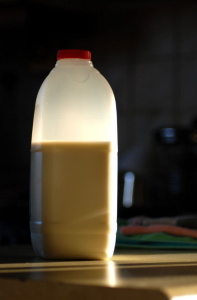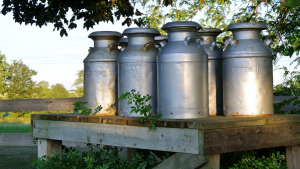We all know that milk is one of those foods that is often mentioned as being rich in protein. Even if you are not at all familiar with ingredients in different food, you have probably had your mother repeatedly tell you that you need to drink milk because it has a lot of proteins, which is good for you. This article will analyze different types of milk that are usually found in stores and try to answer this question. By the end of it, you should know more about milk than simply that it is good for your health and you should drink it often. We will also touch upon some potential issues that may arise from excessive milk consumption as well as problems that people with certain health complications can experience due to milk consumption.
Protein is one of the essential substances in our nutrition and this is precisely why people often wonder about precise amounts of protein in different types of food. Suggested daily intake of protein for an adult male is about 56 g while for an adult female it is 46 g.
How Much Protein In Milk
The amounts for teenage boys and girls are only slightly lower than the suggested amounts for adults while school-age kids may require anywhere between 19 g and 36 g per day.
How much of this daily requirement is fulfilled by milk? A simple answer would be that a glass of milk, which contains 8 g of protein, satisfies about 14% of adult males and slightly under 18% for adult females.

If your nutrition is well balanced otherwise, experts suggest three glasses of milk a day for adults and two glasses per day for children. Seeing how important protein is for the development of your body, milk represents a great source of this nutrient. Unlike other protein-rich food, which may require a longer time to prepare, you can have a glass of milk within a matter of seconds and go about your business.
Protein In Cow Milk
Cow milk makes for almost 85% of the overall milk production in the world. However, it is not as rich in protein as some other types of milk, like example sheep milk which abounds in protein. The above-mentioned facts mostly pertain to cow milk.
When it comes to cow milk, the amount of protein depends on what exact type we are talking about. The two main subtypes of cow milk are whole milk and skimmed milk.
How Much Protein In Whole Milk
Interestingly enough, whole milk contains a bit lower percentage of protein than skimmed milk. The amount of protein in one cup (8 oz or 244 g) of whole milk is 7.86 g and it provides 146 calories. Apart from protein, it also contains 7.93 g of fat and 11 g of carbohydrates.
As for vitamins, milk is rich in vitamins A and E, while the main minerals contained in the whole milk are calcium (276 mg), potassium (349 mg), sodium (98 mg), and magnesium (24 mg).
How Much Protein In Skim Milk
The most important difference between the whole and skim milk is the absence of fats in the latter. One glass of skim milk contains only about 0.20 g of fats. At the same time, protein levels in skim milk are slightly higher as they amount to 8,26 g.
Skim milk also contains far fewer calories than whole milk. A cup of this milk only contains 83 g, but at the same time, it contains slightly more carbohydrates, 12,15 g.
As for the vitamin and mineral content, skim milk is somewhat richer than its fatter brother. For example, the amount of Vitamin A in skim milk is 149 mcg as opposed to 68 mcg in the whole milk, the amount of calcium is 306 mg, and the amount of potassium is 382 mg.

Protein In Buffalo Milk
Although not nearly as popular as cow milk, buffalo milk represents a very rich and valuable source of nutrients. While it is widely used in India, due to its health benefits, this milk variety is slowly finding its way to other corners of the world.
Protein content in buffalo milk is slightly higher than in cow milk and it amounts to 9.15 g in one 8 oz cup. It is also very rich in fats, with 16,81 g in one serving, and a good source of energy with 237 calories.
Buffalo milk is also very rich in minerals, significantly richer than cow milk.
- Calcium: 412 g
- Magnesium: 76 g
- Potassium: 434 g
- Phosphorus: 285 g
Health Benefits And Potential Issues Of Milk Consumption
With so many important ingredients, it is clear that milk can be truly beneficial for your health. Apart from the evident benefits of protein intake, calcium and phosphorus that abound in milk are very helpful for the development and sturdiness of your bones.
Regular milk consumption can also reduce the risk of cardiovascular diseases. The reason for this beneficial effect is, once again, calcium. Numerous studies have indicated that calcium can help reduce levels of bad cholesterol, which is one of the main causes of cardiovascular diseases.
There is also evidence to suggest that regular milk intake helps with the prevention of the development of cancerous cells in the body, especially in terms of breast and colorectal cancer.
With all these added benefits, milk is also great for hydrating your body and maintaining your fluids at appropriate levels.
As for the health complications connected to milk consumption, the most common one is cow milk protein intolerance or allergy. Two main proteins in milk that can cause an allergic reaction are whey and casein. Most people allergic to cow milk will also have a bad reaction to other types of milk, including buffalo milk. The allergy is caused by an abnormal reaction of your immune system to these common proteins, which are being wrongly identified. There is no real treatment for this condition apart from avoiding milk and other food containing the said proteins. Luckily, in most cases, especially with children, this allergy disappears over time.
Hopefully, this article was able to answer not only the question of how much protein there is but also presented you with some other interesting and relevant facts concerning this widespread nutritional product.
Image Credit
Images shared via creative commons 2.0 – https://creativecommons.org/licenses/by/2.0/
Image One by Conor Lawless – https://www.flickr.com/photos/conchur/329035709/
Image Two by RichardBH – https://www.flickr.com/photos/rbh/7737121246/